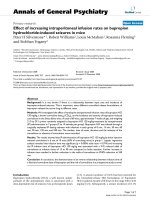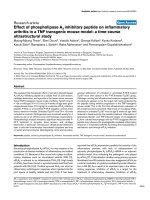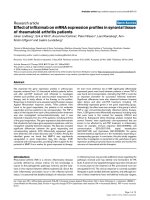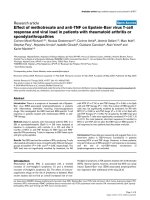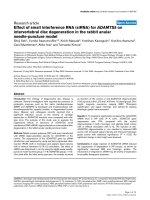Báo cáo y học: "Effect of levosimendan in experimental verapamilinduced myocardial depression" pot
Bạn đang xem bản rút gọn của tài liệu. Xem và tải ngay bản đầy đủ của tài liệu tại đây (530.02 KB, 7 trang )
Kurola et al. Scandinavian Journal of Trauma, Resuscitation and Emergency Medicine
2010, 18:12
Open Access
ORIGINAL RESEARCH
© 2010 Kurola et al; licensee BioMed Central Ltd. This is an Open Access article distributed under the terms of the Creative Commons
Attribution License ( which permits unrestricted use, distribution, and reproduction in
any medium, provided the original work is properly cited.
Original research
Effect of levosimendan in experimental verapamil-
induced myocardial depression
Jouni Kurola*
1
, Heli Leppikangas
2
, Jarkko Magga
1
, Leena Lindgren
2
, Vesa Kiviniemi
3
, Juha Rutanen
1
and
Esko Ruokonen
1
Abstract
Background: Calcium antagonist overdose can cause severe deterioration of hemodynamics unresponsible to
treatment with beta adrenergic inotropes. The aim of the study was to evaluate in an experimental model the effects of
levosimendan during severe calcium antagonist intoxication.
Methods: Twelve landrace-pigs were intoxicated with intravenous verapamil at escalating infusion rates. The infusion
containing 2.5 mg/ml verapamil was used aiming to a reduction of cardiac output by 40% from the baseline value.
Intoxicated pigs were randomized into two groups: control (saline) and levosimendan (intravenous bolus). Inotropic
effect was measured as a change in a maximum of the positive slope of the left ventricular pressure (LV dP/dt). The
survival and hemodynamics of the animals were followed for 120 min after the targeted reduction of cardiac output.
Results: In the control group, five out of six pigs died during the experiment. In the levosimendan group, one pig died
before completion of the experiment (p = 0.04). In the levosimendan group a change in LV dP/dt was positive in four
out of six pigs compared to one out of six pigs in the control group (p = ns).
Conclusions: In this experimental model, the use of levosimendan was associated with improved survival.
Background
In the year 2004 more than 10000 toxic exposures to cal-
cium channels blockers were reported in the United
States. Of those exposures, 3.3% were associated with
severe bradycardia, hypotension and acute negative inot-
ropy. Altogether, there were 62 (0.6%) deaths due to cal-
cium channel blocker overdoses. Verapamil and diltiazem
involved the majority of these fatal poisonings [1]. The
majority of the exposures occurred accidentally (79%),
but a significant (18%) part was suicide attempts. More-
over, a small amount of overdoses was in children or due
to iatrogenic treatments [1]. The number of toxic inci-
dents is increasing [2,3].
Calcium channel blocker overdose causes intractable
hypotension, bradycardia, cardiac conduction abnormali-
ties and depression of myocardial contractility, leading to
central nervous system (e.g. syncope, seizures and coma),
respiratory (non-cardiogenic pulmonary edema) and
metabolic (e.g. hyperglycemia and acidosis) disorders [4].
The management of calcium channel blocker poisoning
includes the use of a wide variety of medications and also
non-pharmacological techniques [4]. The aims are to
support vital functions and, on the other hand, to prevent
the further absorption of calcium channel blockers from
the gut with lavage and activated charcoal. The manage-
ment of the cardiovascular symptoms is focused on nor-
malization of sinus rate by atropine as well as pacing and
restoration of normal arterial pressure (plasma volume
expanders and catecholamines). The negative inotropy
can be partly reversed by using β-adrenergic agonists,
phosphodiesterase inhibitors, glucagon, insulin with dex-
trose and calcium salts [5]. Also a case report regarding
the use of levosimendan has been published [6].
Both verapamil and diltiazem decrease myocardial con-
tractility [7] at high plasma concentrations, as seen in
acute poisoning [8]. The negative inotropy caused by
these drugs is due to a direct cardiac effect, shown in
vitro in Langendorff perfused isolated hearts [9]. The sus-
tained effect of verapamil may be related to its active
hepatic metabolite, nor-verapamil, which has 50% of the
potency of the parent compound [10]. The symptoms of
calcium channel blocker overdose do not always respond
* Correspondence:
1
Department of Intensive Care, Kuopio University Hospital, Kuopio, Finland
Kurola et al. Scandinavian Journal of Trauma, Resuscitation and Emergency
Medicine 2010, 18:12
Page 2 of 7
to treatment with conventional beta adrenergic drugs. A
rather new calcium sensitizer, levosimendan, is targeted
to treatment of acute decompensated heart failure. Levo-
simendan induces a positive inotropic effect mediated
through calcium-dependent binding of the compound to
troponin C [11,12]. This mechanism of action increases
sensitivity of contractile proteins for calcium. Levosimen-
dan works also under extreme conditions e.g. acidosis
[13] and sepsis [14]. Levosimendan also causes coronary
dilation and systemic vasodilatation [15] through open-
ing of ATP-sensitive potassium channels [16].
The aim of our study was to assess the effects of levosi-
mendan in experimental porcine poisoning model of
severe verapamil intoxication.
Methods
National Animal Ethics Committee of Finland approved
the method. The animal care, welfare and procedures
were carried out in accordance with the regulations of the
Council of Europe.
Animals and anesthesia
Twelve [12] landrace- pigs (28 ± 5 kg) were deprived of
food, but not water 12 h before the experiments. Premed-
ication with medetomidine 50 μg/kg, ketamine 10 mg/kg
and fentanyl 5 μg/kg intramuscularly was followed by
cannulation of an ear vein and intravenous administra-
tion of 2 mg/kg of propofol for tracheotomy. Anesthesia
was maintained with propofol (10 mg/kg/hour) and fen-
tanyl (30 μg/kg/hour). The animals were ventilated with a
volume-controlled mode (Servo 900, Siemens, Elema AB,
Solna Sweden) with 5 cmH
2
O of positive end-expiratory
pressure (PEEP). FIO
2
(0.3-0.6) was adjusted to keep PaO
2
levels between 13.3 kPa to 20 kPa. Tidal volume was kept
at 10 ml/kg, and the minute ventilation was adjusted to
maintain PaCO
2
levels between 4.5 to 5.5 kPa.
Animal preparation
A fluid-filled catheter was inserted into the right femoral
artery (single-lumen central venous catheter, Arrow,
Arrow International Inc, Reading, PA) and a pulmonary
artery catheter (7.5F flow-directed, Arrow, Arrow Inter-
national Inc, Reading, PA) introduced via the right inter-
nal jugular vein. The angiography (Impulse™, Boston
Scientific, USA) catheter was inserted into left ventricle
via left femoral artery to measure a change in a maximum
of the positive slope of the left ventricular pressure
(LVdP/dt). During instrumentation, the animals received
5 ml/kg/h infusions of 0.9% saline and gelatin (Gelo-
fusine
®
, B. Braun Medical, Germany). Additional fluid was
administered if necessary to keep pulmonary artery
occlusion pressure (PAOP) between 5 and 8 mmHg. Body
temperature of the animals was kept above 38°C using an
operating table heater and warmed fluids.
Experimental protocol
After instrumentation, a stabilization period of at least 30
minutes was allowed followed by the baseline measure-
ments. Verapamil intoxication was then induced by a
long-lasting intravenous infusion containing 2.5 mg/ml of
verapamil at an escalating rate into the right internal jug-
ular vein. The rate of verapamil infusion was increased by
2.5 ml/h in every 15 minutes. The infusion was targeted
to decrease cardiac output 40% from the baseline value.
The administration and the amount of verapamil were
based on a pilot trial in three pigs.
At completion of the verapamil intoxication phase,
both the control and the levosimendan groups received a
continuous infusion of verapamil 12.5 mg/h to maintain
the toxicity level. Thereafter, animals in the control group
received 25 ml bolus of saline in 15 minutes and the levo-
simendan group 1.25 mg levosimendan (Simdax
®
, Orion
Pharma, Espoo, Finland) in the same volume and time.
Arterial blood samples were obtained in heparinezed
tubes at Intox 0 and in the end of experiment for mea-
surement of plasma concentrations of verapamil and nor-
verapamil, calcium, lactate, sodium, potassium and glu-
cose. The analytical method used was liquid chromatog-
raphy-mass spectrometry. At the end of experiment, the
surviving animals were killed with a high dose of vera-
pamil. The total dose of verapamil given to the pigs was
recorded at the end of the experiment.
Hemodynamic monitoring
Left ventricular pressure (LVP), mean arterial pressure
(MAP), central venous pressure (CVP), end diastolic
pressure (EDP) and pulmonary artery occlusion pressure
(PAOP) were recorded with quartz pressure transducers
and displayed continuously on a multimodular monitor
(S/5 Compact Critical Care Monitor, Datex-Ohmeda™,
Helsinki, Finland). All pressure transducers were cali-
brated simultaneously and zeroed to the level of the
heart. The inotropic effect was measured as a change in a
maximum of the positive slope of the left ventricular
pressure (LV dP/dt). LV dP/dt was measured once a min-
ute which represent a mean value over one minute car-
diac cycles. A mean value of 5 minutes was recorded and
its coefficient of variation in the control group was 3.6%
(2.2; 5.8) and 4.1% (1.8; 10.5) in the levosimendan group
(ns). Cardiac output (CO) was measured by a thermodi-
lution technique and mean value of three measurements
was used with room temperature saline injectates of 5 ml.
(Datex-Ohmeda™, Helsinki, Finland). Heart rate (HR) was
measured from the continuously monitored ECG.
Statistical analysis
Mann-Whitney test was used to analyze differences in
hemodynamic and laboratory measures at preintoxica-
tion (baseline) and postintoxication (from Intox 0 to
Kurola et al. Scandinavian Journal of Trauma, Resuscitation and Emergency
Medicine 2010, 18:12
Page 3 of 7
Intox 120) phases. Values are presented as median and
interquartale range. Statistical analyses were done using a
statistical program SPSS for Windows version 14.0 (SPSS
®
Inc. Chicago, USA). P-values of less than 0.05 were con-
sidered statistically significant.
Results
Baseline data on hemodynamics and the laboratory val-
ues of calcium and lactate are presented in Tables 1 and 2.
There was no difference between the groups in baseline
data excluding hemoglobin, which was higher in the levo-
Table 1: Comparison of hemodynamic values (median, IQR) between groups before verapamil infusion (Baseline) and at
the time when intoxication was complete (Intox 0) (p = ns between levosimendan and control groups in both baseline and
intox 0).
Baseline Intox 0
MAP
control 95 (75;103) 43 (39;50)
levosimendan 100 (93;106) 44 (44;55)
CO
control 4.6 (3.4;5.5) 2.4 (1.9;2.8)
levosimendan 4.4 (4.1;4.7) 2.1 (2.0;2.2)
LV dP/dt (mmHg/s)
control 1730 (1548;1901) 761 (609;778)
levosimendan 2096 (2014;2238) 624 (518;736)
HR (beats/min)
control 111 (98;132) 84 (78;94)
levosimendan 103 (95;111) 85 (72;93)
CVP (mmHg)
control 6 (5;6) 7 (7;8)
levosimendan 5 (4;7) 7 (5;8)
EDP (mmHg)
control 19 (12;23) 13 (11;15)
levosimendan 15 (13;16) 15 (12;16)
Kurola et al. Scandinavian Journal of Trauma, Resuscitation and Emergency
Medicine 2010, 18:12
Page 4 of 7
simendan group 73 (68; 73) g/l vs. 65 (66; 73) g/l (p =
0.04).
In each animal, cardiac output decreased by 40% as
planned. In the planned control group the reduction was
45% (43; 54) and in the planned levosimendan group 49%
(44; 50) (p = ns). The dose of verapamil required to
induce toxicity was 22 (22; 37) mg and it took 53 (45; 71)
minutes in the future control group and 22 (16; 29) mg
and 53 (34; 60) minutes in the future levosimendan group
(p = ns). Total amount of verapamil infused for both
intoxication and maintainance period was 42 (38; 46) mg
in the control group and 47 (46; 50) mg in levosimendan
group (p = ns). Plasma concentrations of verapamil and
nor-verapamil at Intox 0 were in the levosimendan group
238.0 (222.0; 385.0) ng/ml and 3.0 (2.5; 8.1) ng/ml com-
pared to the control group 293.5 (217.5; 365.5) ng/ml and
5.1 (2.2; 8.4) ng/ml (p = ns), respectively. There were no
differences between levosimendan and control groups in
verapamil and nor-verapamil concentrations between
groups at the end of experiment 279.5(226.0; 315.0) ng/
ml and 11.3 (10.4; 13.7) ng/ml vs. 300.0 (223.0; 339.8) ng/
ml and 9.6 (9.8; 14.3) ng/ml (p = ns), respectively.
The hemodynamic and the laboratory data of lactate
and calcium at the time point when intoxication was
complete (Intox 0) are presented in Tables 1 and 2, and
there were no differences between groups. There were no
differences between groups in laboratory values at the
end of the experiment (p = ns). The laboratory values of
sodium, potassium and glucose were comparable
between groups throughout the experiment (p = ns).
Five out of six pigs died during the experiment in the
control group. In the levosimendan group one pig died
before completion of the experiment. The median time
alive from the completion of intoxication was 75 (60; 101)
minutes in the control group and 120 (120; 120) minutes
in the levosimendan group, respectively. The Kaplan-
Meier survival curve is presented in Figure 1 (p = 0.04).
After completion of intoxication, the group receiving
levosimendan had a tendency towards higher LV dP/dt
than the control group, however there were no statisti-
cally significant differences either in LV dP/dt, CO, HR,
MAP, CVP and EDP between groups (Figure 2, 3 and 4).
Table 2: Comparison of calcium and lactate values (median, IQR) between groups before verapamil infusion (Baseline), at
the time when intoxication was complete (Intox 0) and right before clinically estimated collapse of hemodynamics (End of
experiment) (p > 0.05 between the groups).
Baseline Intox 0 End of experiment
Ca (mmol/l)
control 1.20 (0.98;1.30) 1.10 (1.01;1.38) 1.06 (0.85;1.21)
levosimendan 1.02 (0.96;1.27) 1.00 (0.89;1.11) 0.98 (0.84;1.15)
Lactate (mmol/l)
control 0.8 (0.6;0.7) 1.9 (1.1;1.9) 6.6 (4.7;8.7)
levosimendan 0.6 (0.6;0.7) 1.1 (0.9;1.4) 6.7 (1.2;8.6)
Figure 1 Kaplan-Meier survival curve in levosimendan (LEVO)
and control (CON) groups.
0 20406080100120
1
2
3
4
5
6
Number of animals alive
Time
LEVO
CON
Kurola et al. Scandinavian Journal of Trauma, Resuscitation and Emergency
Medicine 2010, 18:12
Page 5 of 7
Discussion
The main finding of our study was that levosimendan
improved survival in severe verapamil intoxication. In
our experimental model, verapamil resulted in negative
inotropy in control group assessed with dPdT. In con-
trast, heart rate was less prominently affected.
Verapamil intoxication is related to its intended action
on myocardial and smooth muscle cells, where it compet-
itively blocks cell surface slow calcium channels. Inhibi-
tion of calcium influx is responsible for depression of
contractility causing a myocardial stunning-like syn-
drome [17-20]. The function and mechanical efficiency of
stunned myocardium is depressed due to decreased sen-
sitivity of the myofibrils to calcium [18].
Levosimendan enhances cardiac contraction by
improving the use of available calcium rather by inundat-
ing the cell with excessive calcium [21]. The use of tradi-
tional inotropes is associated with increased energy
consumption and arrhythmogenesis due to elevated
intracellular calcium concentration leading to apoptosis
in long term use [22,23]. Levosimendan causes vasodila-
tation via opening of adenosine triphosphatase-sensitive
K
+
channels [24]. This effect may contribute to coronary
[25] and systemic [26] vasodilatation with the intrave-
nous administration of levosimendan.
Figure 2 Cardiac output (CO) and Maximum of the positive slope
of the left ventricular pressure (LV dP/dt) for control (CON) and le-
vosimendan (LEVO) groups(median ± IQR) versus time (in min-
utes).
0 15 30 45 60 75 90 105 120
0,0
0,5
1,0
1,5
2,0
2,5
3,0
3,5
4,0
CO
Time
LEVO
CON
0 15 30 45 60 75 90 105 120
200
300
400
500
600
700
800
900
1000
1100
1200
DPDT
Time
LEVO
CON
Figure 3 End diastolic pressure (EDP, mmHg) and central venous
pressure (CVP, mmHg), for control (CON) and levosimendan (LE-
VO) groups (median ± IQR) versus time (in minutes). Number of
surviving animals is presented under the x- axis at each time point.
0 153045607590105120
0
5
10
15
20
levo n= 6 6 6 6 5 5 5 5 5
con n= 6 6 5 5 4 3 3 1 1
EDP mmHg
Time
LEVO
CON
0 153045607590105120
0
2
4
6
8
10
levo n= 6 6 6 6 5 5 5 5 5
con n= 6 6 5 5 4 3 3 1 1
CVP mmHg
Time
LEVO
CON
Kurola et al. Scandinavian Journal of Trauma, Resuscitation and Emergency
Medicine 2010, 18:12
Page 6 of 7
The levosimendan bolus was well tolerated. Even
though the vasodilating effect of levosimendan has been
well documented [26-28] it is noteworthy that it did not
have deleterious effect on mean arterial pressure. It is
conceivable that the inotropic effect of levosimendan was
more prominent than the vasodilating effect.
Inotropic effect was measured as a change in a maxi-
mum of the positive slope of the left ventricular pressure
(LV dP/dt). In the levosimendan group LV dP/dt
increased by 38% from the baseline to the Intox 60 min-
utes, whereas LV dP/dt decreased in the control group by
31% during the same time interval. The same trend was
seen for CO, but due to the small number of surviving
animals in the control group, a significant difference was
not reached between study groups. There were no clinical
or statistical differences in HR, MAP, CVP and EDP
between the study groups.
The first limitation of the study is that an animal model
is not exactly like the toxicity seen in human beings. We
chose a pig model because it has been used in previous
studies of verapamil toxicity [29], and pigs have similar
cardiovascular systems as humans [30]. The second limi-
tation is the small number of animals and the survival
rate was very low in control group; therefore detailed sta-
tistical analysis of hemodynamic differences between the
groups was not possible. The third limitation is the use of
intravenous verapamil as a substitute for oral ingestion
that can prolong the absorption of verapamil. This limita-
tion was minimized by continuing the verapamil infusion
throughout the study to mimic oral ingestion. On the
other hand, concentrations of verapamil and its active
metabolite, nor-verapamil, were about similar in the two
study groups. Although oral ingestion might have a dif-
ferent pharmacokinetics, according to hemodynamic
data, we induced a severe verapamil poisoning.
In summary, treatment with levosimendan improved
survival in pigs severly poisoned with verapamil. Levosi-
mendan seemed to maintain cardiac performance espe-
cially during the early phase of intoxication without
excessive vasodilatation. Confirmation of the effective-
ness of levosimendan for pharmacotherapy of verapamil
intoxication in humans requires further experiments.
Competing interests
The authors declare that they have no competing interests.
Authors' contributions
JK and HL participated to the design of the study, performed the study and
prepared the manuscript. ER designed the study and prepared the manuscript.
JR performed the study. JM and LL participated to the design of the study and
VK made statistical analysis. All authors read and approved the final manu-
script.
Author Details
1
Department of Intensive Care, Kuopio University Hospital, Kuopio, Finland,
2
Department of Anesthesiology, Tampere University Hospital, Tampere, Finland
and
3
IT Centre, Kuopio University, Kuopio, Finland
References
1. Watson WA, Litovitz T, Rodgers GC, Klein-Schwartz W, Reid N, Youniss J,
Flanagan A, Wruk KM: 2004 Annual Report of the American Association
of Poison Control Centers Toxic Exposure Surveillance System. Am J
Emerg Med 2005, 23(5):589-666.
2. Litovitz TL, Klein-Schwartz W, White S, Cobaugh DJ, Youniss J, Omslaer JC,
Drab A, Benson BE: Annual Report of the American Association of
Poison Control Centers Toxic Exposure Surveillance System. Am J
Emerg Med 2001, 19:337-395.
3. Litovitz TL, Klein-Schwartz W, Rodgers GC, Cobaugh DJ, Youniss J, Omslaer
JC, May ME, Woolf AD, Benson BE: 2001 Annual report of the American
Received: 26 October 2009 Accepted: 11 March 2010
Published: 11 March 2010
This article is available from: 2010 Kurola et al; licensee BioMed Central Ltd. This is an Open Access article distributed under the terms of the Creative Commons Attribution License ( which permits unrestricted use, distribution, and reproduction in any medium, provided the original work is properly cited.Scandinavi an Journal of Trau ma, Resuscita tion and Emergenc y Medicine 2010, 18:12
Figure 4 Heart rate (HR, beats/min) and mean arterial pressure
(MAP, mmHg) for control (CON) and levosimendan (LEVO) groups
(median ± IQR) versus time (in minutes). Number of surviving ani-
mals is presented under the x- axis at each time point.
0 153045607590105120
0
20
40
60
80
100
120
levo n= 6 6 6 6 5 5 5 5 5
con n= 6 6 5 5 4 3 3 1 1
HR /min
Time
LEVO
CON
0 153045607590105120
0
5
10
15
20
25
30
35
40
45
50
55
60
65
70
levo n= 6 6 6 6 5 5 5 5 5
con n= 6 6 5 5 4 3 3 1 1
MAP mmHg
Time
LEVO
CON
Kurola et al. Scandinavian Journal of Trauma, Resuscitation and Emergency
Medicine 2010, 18:12
Page 7 of 7
Association of Poison Control Centers Toxic Exposure Surveillance
System. Am J Emerg Med 2002, 20(5):391-452.
4. Lip GY, Ferner RE: Poisoning with anti-hypertensive drugs: calcium
antagonists. J Hum Hypertens 1995, 9:155-161.
5. Gay R, Algeo S, Lee R, Olajos M, Morkin E, Goldman S: Treatment of
verapamil toxicity in intact dogs. J Clin Invest 1986, 77:1805-1811.
6. Varpula T, Rapola J, Sallisalmi M, Kurola J: Treatment of serious calcium
channel blocker overdose with levosimendan, a calcium sensitizer.
Anesth Analg 2009, 108:790-792.
7. Schoffstall JM, Spivey WH, Gambone LM, Shaw RP, Sit SP: Effects of
calcium channel blocker overdose-induced toxicity in the conscious
dog. Ann Emerg Med 1991, 20:1104-1108.
8. Kivistö KT, Neuvonen PJ, Tarssanen L: Pharmacokinetics of verapamil in
overdose. Hum Exp Toxicol 1997, 16:35-37.
9. Zaritsky AL, Horowitz M, Chernow B: Glucagon antagonism of calcium
channel blocker-induced myocardial dysfunction. Crit Care Med 1988,
16:246-251.
10. Neugebauer G: Comparative cardiovascular actions of verapamil and its
major metabolites in the anaesthetised dog. Cardiovasc Res 1978,
12:247-254.
11. Haikala H, Kaivola J, Nissinen E, Wall P, Levijoki J, Linden IB: Cardiac
troponin C as a target protein for a novel calcium sensitizing drug,
levosimendan. J Mol Cell Cardiol 1995, 27:1859-1866.
12. Sorsa T, Heikkinen S, Abbott MB, Abusamhadneh E, Laakso T, Tilgmann C,
Serimaa R, Annila A, Rosevear PR, Drakenberg T, Pollesello P, Kilpelainen I:
Binding of levosimendan, a calcium sensitizer, to cardiac troponin C. J
Biol Chem 2001, 276:9337-9343.
13. Haikala H, Nissinen E, Etemadzadeh E, Levijoki J, Lindén IB: Troponin C-
mediated calcium sensitization induced by levosimendan does not
impair relaxation. J Cardiovasc Pharmacol 1995, 25:794-801.
14. Morelli A, De Castro S, Teboul J-L, Singer M, Rocco M, Conti G, De Luca L,
Di Angelantonio E, Orecchioni A, Pandian NG, Pietrapaoli P: Effects of
levosimendan on systemic and regional hemodynamics in septic
myocardial depression. Intensive Care Med 2005, 31:638-644.
15. Pagel PS, Harkin CP, Hettrick DA, Warltier DC: Levosimendan (OR-1259), a
myofilament calcium sensitizer, enhances myocardial contractility but
does not alter isovolumic relaxation in conscious and anesthetized
dogs. Anesthesiology 1994, 81:974-987.
16. Pataricza J, Hohn J, Petri A, Balogh A, Papp JG: Comparison of the
vasorelaxing effect of cromakalim and the new inodilator,
levosimendan, in human isolated portal vein. J Pharm Pharmacol 2000,
52:213-217.
17. Bolli R, Marban E: Molecular and cellular mechanisms of myocardial
stunning. Physiol Rev 1999, 79:609-34.
18. Hearse DJ, Tosaki A: Free radicals and calcium: Simultaneous interacting
triggers as determinants of vulnerability to reperfusion-induced
arrhythmias in the rat heart. J Mol Cell Cardiol 1988, 20:213-223.
19. Soei LK, Sassen LM, Fan DS, van Veen T, Krams R, Verdouw PD: Myofibrillar
Ca
2+
sensitization predominantly enhances function and mechanical
efficiency of stunned myocardium. Circulation 1994, 90:959-69.
20. Rosen MR, Wit AL, Hoffman BF: Electrophysiology and pharmacology of
cardiac arrhythmias. VI. Cardiac effects of verapamil. Am Heart J 1975,
89:665-673.
21. Hasenfuss G, Pieske B, Castell M, Kretschmann B, Maier LS, Just H:
Influence of the novel inotropic agent levosimendan on isometric
tension and calcium cycling in failing human myocardium. Circulation
1998, 98:2141-47.
22. Packer M, Carver JR, Rodeheffer RJ, Ivanhoe RJ, DiBianco R, Zeldis SM,
Hendrix GH, Bommer WJ, Elkayam U, Kukin ML, Mallis GI, Sollano JA,
Shannon J, Tandon PK, DeMets DL: Effects of oral milrinone on mortality
in severe chronic heart failure. N Engl J Med 1991, 325:1468-1475.
23. Feldman AM, Bristow MR, Parmley WW, Carson PE, Pepine CJ, Gilbert EM,
Strobeck JE, Hendrix GH, Powers ER, Bain RP, White BG, the Vesnarinone
Study Group: Effects of vesnarinone on morbidity and mortality in
patients with heart failure. N Engl J Med 1993, 329:149-155.
24. Yokoshiki H, Katsube Y, Sunagawa M, Sperelakis N: Levosimendan, a
novel Ca
2+
sensitizer, activates the glibenclamide-sensitive K+ channel
in rat arterial myocytes. Eur J Pharmacol 1997, 333:249-259.
25. Michaels AD, McKeown B, Kostal M, Vakharia KT, Jordan MV, Gerber IL,
Foster E, Chatterjee K: Effects of intravenous levosimendan on human
coronary vasomotor regulation, left ventricular wall stress, and
myocardial oxygen uptake. Circulation 2005, 111:1504-1509.
26. Slawsky MT, Colucci WS, Gottlieb SS, Greenberg BH, Haeusslein E, Hare J,
Hutchins S, Leier CV, LeJemtel TH, Loh E, Nicklas J, Ogilby D, Singh BN,
Smith W, on behalf of the Study Investigators: Acute hemodynamic and
clinical effects of levosimendan in patients with severe heart failure.
Circulation 2000, 102:2222-2227.
27. Gruhn N, Nielsen Kudsk JE, Theilgaard S, Bang L, Olesen SP, Aldershvile J:
Coronary vasorelaxant effect of levosimendan, a new inodilator with
calcium-sensitizing properties. J CardiovascPharmacol 1998, 31:741-749.
28. Yokoshiki H, Sperelakis N: Vasodilating mechanisms of levosimendan.
Cardiovasc Drugs Ther 2003, 17:111-113.
29. Tanen D, Ruha A-M, Curry S, Graeme KA, Reagan CG: Hypertonic sodium
bicarbonate is effective in the acute management of verapamil toxicity
in a swine model. Ann Emerg Med 2000, 36(6):547-53.
30. Hughes HC: Swine in cardiovascular research. Lab Anim Sci 1986,
36:348-350.
doi: 10.1186/1757-7241-18-12
Cite this article as: Kurola et al., Effect of levosimendan in experimental vera-
pamil- induced myocardial depression Scandinavian Journal of Trauma,
Resuscitation and Emergency Medicine 2010, 18:12

